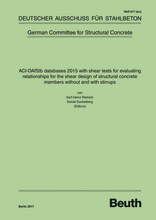
Publication DAfStb-Heft 617 2017-03
ACI-DAfStb databases 2015 with shear tests for evaluating relationships for the shear design of structural concrete members without and with stirrups
- Publisher
- DAfStb, Dunkelberg, Daniel, Reineck, Karl-Heinz, et al.
- Publisher
- DAfStb, Dunkelberg, Daniel, Reineck, Karl-Heinz, et al.
Product information on this site:
Quick delivery via download or delivery service
All transactions are encrypted
Design provisions in most codes of practice for shear are primarily empirical and almost exclusively derived from test data, as described by ASCE-ACI Committee 445 in 1998, for example. While most shear design provisions are tied to the parallel chord truss model, this model is only suitable for the determination of strength; it does not consider compatibility of deformations or constitutive properties and does not directly provide a means of evaluating the angle of diagonal struts in the truss. Consequently, all design approaches rely on test data for either the derivation of a purely empirical design formula or for the validation of design rules for the models. Therefore, tests on beams are principally used to confirm such design rules. The development of standardized shear databases started in 1997, when a database was established by Reineck (1999) and checked by Hegger and Görtz (1999), König and Schenck (1999) and Zilch and Staller (1999). Parallel to this effort, Kuchma started an extensive data collection effort on members both with and without transverse reinforcement. Reineck and Kuchma then merged their databases and published a first joint version in 2003. This was further extended to the shear database eventually published in 2012 by Reineck, Kuchma and Fitik (see DAfStb-Heft 597). An essential feature of these databases was the definition of criteria for a systematic control of the test data and their selection for a comparison with design proposals. These criteria were discussed and generally agreed upon in different national and international working groups, the above mentioned German group from 1999, the CEB Task Group 2.7 (see CEB Bulletin 237(1997)), the fib Task Group TG 4.3 (see fib Bulletin 12(2001)), and since 2000 in the ACI Subcommittee 445-D within the joint ACI-ASCE Committee 445 "Shear and Torsion". Since 2010 the groups merged their efforts within the ACI-DAfStb Group "Shear Databases". Therefore, these criteria, the minimum requirements and the conversion factors for the strength values can be regarded as internationally accepted, and they are described in Part 1 of this Research Report jointly for all databases. This report has a total of seven parts. As stated before, in Part 1, all the relevant criteria are explained in detail. Part 2 of this report covers the different databases with shear tests on reinforced concrete beams without stirrups. Part 3 deals with the database of shear tests on prestressed concrete beams without stirrups and that were subjected to point loads. Part 4 covers the databases with shear tests on reinforced concrete beams with vertical stirrups. Part 5 describes the database with shear tests on prestressed concrete beams with vertical stirrups subjected to point loads. Part 6 covers the shear tests on non-slender reinforced concrete beams with a/d < 2,40 subjected to point loads. Part 7 deals with shear tests on reinforced concrete beams cast with lightweight concrete.
1. Edition, 748 Pages, A4, Paper covers
ISBN 978-3-410-65295-3 | Order number 65295
eBook 978-3-410-65296-0 | Order number 65296
